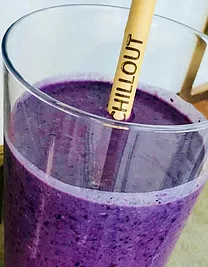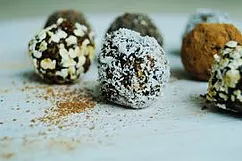Protein shakes have beome part of the furniture in the gyms today, but why is protein so important post-workout and why use a powder over the real thing? Alexandra Fancher explains – also why vegan powders have become the new black + gives you her personal favourite protein smoothie + the recipe for high proteine bliss balls to die for!
How does proteine work?
Protein is essential for the body to grow and repair. Protein-rich food such as dairy, meat, eggs, fish and beans are broken down into amino acids in the stomach and absorbed in the small intestine. Then the liver sorts out which amino acids the body needs and the rest is flushed out in our urine.
How much?
Adults who aren’t particularly active are advised to eat roughly 0.75g of protein per day for each kilogram they weigh. On average, this is 55g for men and 45g for women – or two palm-sized portions of meat, fish, tofu, nuts or pulses.
Good or bad?
The benefits of protein in your diet not only help you maintain and lose weight, but protein also works to stabilize your blood sugar levels, improve your ability to learn and concentrate, reduce brain fog, boost your energy levels, support your muscles and bones and support the absorption of important nutrients.
Not getting enough protein can lead to hair loss, skin breakouts and weight loss as muscle mass decreases. But these side effects are very rare, and largely only occur with those who suffer from eating disorders.
Building muscle
If you are trying to build muscle, protein is helpful yes. Strength-based exercise causes a breakdown of protein in the muscle and for muscles to grow stronger, the proteins need to rebuild. A type of protein called leucine plays a particularly big part in triggering protein synthesis, and help slow down the degradation of muscle tissue.
Some experts even argue that not consuming protein post-workout, could cause the breakdown of muscle to be higher than the synthesis – meaning there’s no net gain in muscle mass. Supplement brands advise drinking protein shakes after a workout to help the growth and repair of muscle tissue, usually in the form of leucine-rich whey protein, a by-product of making cheese.
Tips To Pick A Good Protein Powder:
Protein powders are a quick way to help ensure that your body is nourished and satisfied. People use them for a variety of reasons: to lose weight, to improve sports performance and build muscle mass, and for overall wellness.
But how do you know which protein powder is best to meet your personal health goals? When making that choice, it’s important to know the difference between available protein powders as well as how they stack up against whole food protein sources.
Whole foods vs. protein powder
You can meet your body’s daily protein requirements whether you drink shakes or eat protein as whole foods, however, they don’t offer equal nutrition.
What you may find surprising is that shakes generally contain fewer nutrients than whole foods. This means that shakes can help short term to help you lose weight, but whole foods will offer a bigger nutritional punch.
If you’re in the market for a new protein, here’s a hit-list of what to look for:
What to Look For on the Label
1. Minimal Ingredients. 3-5 is ideal
2. No Foreign Chemicals, Additives, Artificial Sweeteners (Stevia, monk fruit or erythritol)
3. Quality Protein (ideally: Non-Denatured Isolate, Bone Broth/Chicken Broth, Beef Isolate, Grass-fed Whey Concentrate, Collagen, Pea
4. Ideal Stamps of Approval: Non-GMO, No Soy, No Grains, Organic
5. Company Connection. Can you “reach” or connect to the company? Are they honest about their sourcing?
6. Cost. Generally, you get what you pay for. Chances are that $20 formula will leave you more with “max (placebo) muscle” and not much else.
How do I feel?
Your gut is your best guide, but make sure you listen to it. You now know to “shop smart” and be on the lookout for additives, synthesized chemicals, cheap proteins and fillers in supplements, but, at the end of the day, your body’s own signs and symptoms will be a guide as well (i.e. Are you bloated? Running to the restroom after your shake? Stuffy nose and allergies flaring up? Brain fog?, etc.).
A good way to tell if your powder is working for you is to take it out of your food intake completely, for at least one week if not two – then re-introduce it and see for yourself what works better.
Protein trends – whey or vegan?
Historically the protein of choice in the market has been limited and dominated by the whey protein category. Made famous by the 80’s growth of bodybuilding and its superstars such as Arnold Schwarzenegger and Sylvester Stallone, men around the world wanted to imitate these idols and become jacked! However over time, whey protein has become more than just protein. Often packed full of additional additives and manufactured in facilities that also produce other pharmaceutical steroid based products has lead to many products becoming contaminated or worse packed full of chemicals that people simply done want.
Protein as a category has matured and over time. Experimentation has been done with several other plant based protein sources including Soy, Rice and Hemp (illegal through most of Asia, however) Now, a dominant leader has emerged in the plant based protein category and it is pea protein. For East Asia this is interesting, as approximately 65 percent of the human population has a reduced ability to digest lactose after infancy, so vegan protein substitutes is an alternativel for those looking for a whey free protein supplement.
Healthy Protein Packed Smoothie
This shake may be the definition of a perfectly balanced breakfast. It has a healthy high dose of protein—which will help you feel fuller the rest of the day, and a nutritious mix of fruit & green leafs – the darker the colour the more antioxidants, oats, good fats, nuts, seeds and superfoods!

1 cup of Almond Milk or Coconut water
1 scoop of Vanilla Protein powder
1/2 cup of Frozen Mixed Berries
1/3 cup Flaxseeds
1/3 cup oats
1/2 avocado
1/2 cup of spinach leaves
1 tsp Maca powder for energy
1/3 cup Goji Berries
1/3 cup Cacao Nibs
Sprinkle Chia seeds
Sprinkle some Bee Pollen
Raw Chocolate Bliss Balls – healthy, high protein, low sugar treats
These bliss balls do not contain the protein powder, but has high levels of protein ingredients + will take away your worst hunger after a tough workout.

Ingredients:
1/4 cup raw cacao powder
1/2 cup tahini paste
1 cup almond meal (left over from making almond milk)
2tbsp extra virgin coconut oil
1/2 cup coconut flesh (from a fresh coconut)
1/2 cup desiccated coconut
1/3 cup coconut flower nectar
To make:
Blend all the ingredients, refrigerate for 1/2 hour and then roll into little balls
You can decorate with Shredded coconut.
ENJOY your workout and your treats!




